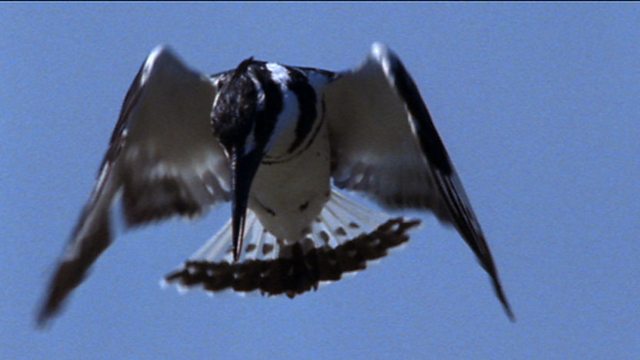
Faster than fishes
A fraction of a second means a miss or a meal for the pied kingfisher.
The pied kingfisher - the largest bird in the world that can hover in still air. At ten metres above the water surface it knows it can't be seen by its prey. To locate a fish it has to keep its head perfectly still. The tail is used to keep it stationary. The wings beat at eight times a second. This uses a lot of energy and the bird can't afford too many misses. In half a second it catches a fish, but it's far from easy. To have any chance of success, it has to get the dive just right. Once it's locked on to its prey it begins a controlled descent. At this point it can still abort the attack if the fish has spotted it. But once it's a couple of metres from the water there is no turning back. The fish must still be oblivious, or it will have time to escape. The next critical moment comes when the beak hits the water surface. Here, it's slowed down two hundred times. Although it is shaped like an arrow and hardly makes a ripple the tip of the beak sends shockwaves through the water. As the beak goes further in, the waves travel further out and are picked out by the sensitive hairs on the fish鈥檚 body. Now, the kingfisher鈥檚 success depends on how quickly the fish reacts. Fish that escape react just one 50th of a second faster than those that get caught.
Duration:
This clip is from
Featured in...
![]()
大象传媒 Nature
Be captivated, informed and inspired by the world's wildlife.
More clips from THE SKILLS TO SURVIVE
-
![]()
Swim like a fish
Duration: 02:14
More clips from Predators
-
![]()
Swim like a fish—THE SKILLS TO SURVIVE
Duration: 02:14
-
![]()
Stun gun—SPECIAL AGENTS
Duration: 03:37
-
![]()
Digital data—SPECIAL AGENTS
Duration: 03:54
-
![]()
Electric predator—NOWHERE TO HIDE
Duration: 04:47






